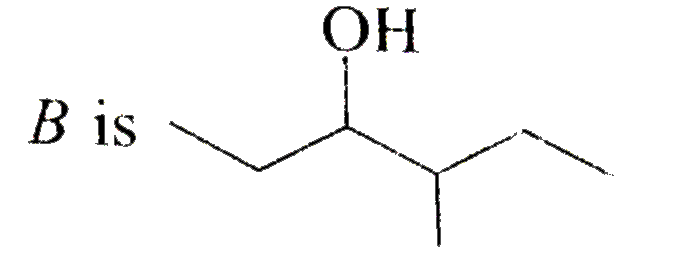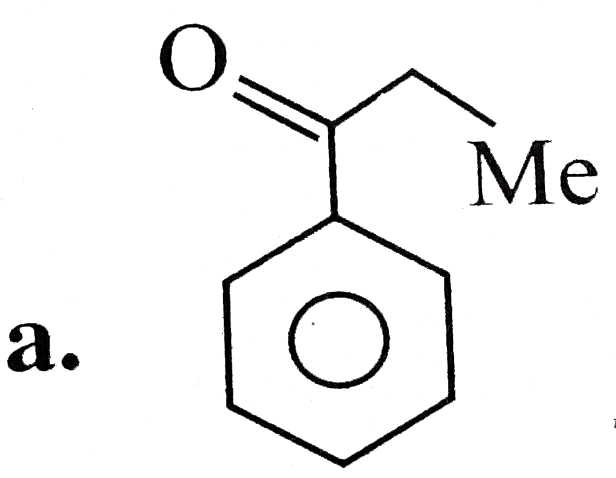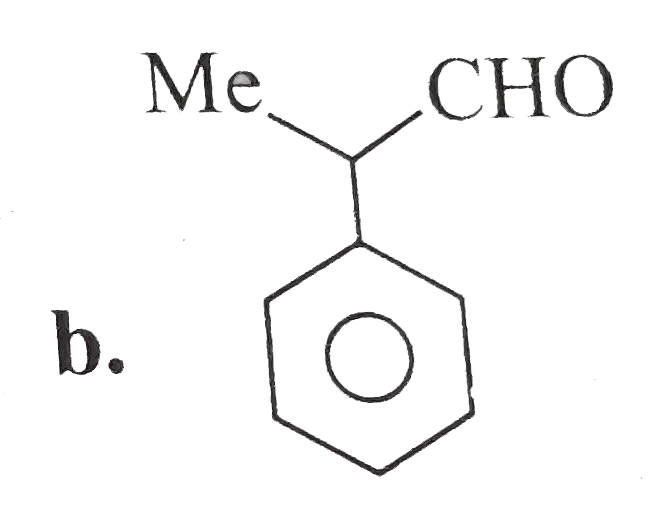C7H14 (A) decolourises Br2 in CI4 and reacts with Hg(Oac)2 in THF H2O following by reduction with NaBH4 to produce a resolvable compounds (B). (A) undergoes reductive ozonolysis to give the same compound (C) obtained by oxidation of hexan-3-ol with KMnO4 . Identify (A), (B), and (C).
i. One DU in (A) and reaction with Br2/CI4 suggest (C=C) group in (A).
ii. 
iii. The formation of (C) suggests that (A) has same skeleton as in (C) with (CH2=) group replacing O.
Possible structure of A, B, and (C) are:
i. 
ii. 
iii. 
Topper's Solved these Questions
- ALCOHOL,PHENOL AND ETHERSBOOK - CENGAGE CHEMISTRYCHAPTER - ALCOHOL,PHENOL AND ETHERSEXERCISE - Exercises Concept Application
33 Videos
- ALCOHOL,PHENOL AND ETHERSBOOK - CENGAGE CHEMISTRYCHAPTER - ALCOHOL,PHENOL AND ETHERSEXERCISE - Exercises Linked Comprehension
60 Videos
- ALCOHOL,PHENOL AND ETHERSBOOK - CENGAGE CHEMISTRYCHAPTER - ALCOHOL,PHENOL AND ETHERSEXERCISE - Solved Examples
17 Videos
- ALIPHATIC AND AROMATIC ALDEHYDES AND KETONESBOOK - CENGAGE CHEMISTRYCHAPTER - ALIPHATIC AND AROMATIC ALDEHYDES AND KETONESEXERCISE - Archives Subjective
29 Videos
Similar Questions
Compound (A), C7H14 discharges Br2 in CCl4 and reacts with (CH3COO)2 Hg in THF−H2O followed by reduction with NaBH4 to produce a resolvable compound (B). (A) undergoes reductive ozonolysis to give the same compound obtained by oxidation of 3 - hexanol (C ). Identify (A), (B) and (C ).
View SolutionGive the products formed on reductive ozonolysis with LAH and oxidative ozonolysis with H2O2, from the compounds in question.
View Solution
Knowledge Check
Compound A (C7H14) decolouries Br2 in CCl4 and reacts with Hg(Oac)2 followed by ruduction with NaBH4 to produce a resolvable compound B.A undergoes redutive ozonolysis to give
 as one of the compound A
as one of the compound A B
B C
C D
D
Compound (A) C12H20 discharges the colour of Br2−H2O and cold KMnO4 . On reduction with H2/Pt it gives compound (B) C12H22 . A on ozonolysis give cyclohexanone . Find structure of A :
A B
B C
C DNone of these
DNone of these(A)(C9H12O)[O]−−−−−−−−→HotKMnO4PhCOOH
i. (A) does not decolourise Br2 in CCl4, reacts with Na to give a colourless and odourless gas (B).
ii. (A) does not give iodoform test.
iii. (A) is a chiral compound and oxidation of (A) with CrO3/Py gives a chiral compound (C ).
iv. The colour of Cr2O2−7 change to blue-green when added to compound (A).
The compound (C ) is:Aa. Bb.
Bb. Cc.
Cc. Dd.
Dd.
An organic compound C4H6 on reductive ozonolysis gives HCHO,CO2 and CH3C=CH−CH=CH2 Find structure of compound.
View SolutionC11H16 (A) reacts with two equivalent of H2 and on reductive ozonolysis gives two equivalent formaldeyde and (B) of the following structure.

Identify structure of (A).
View SolutionDeduct the structural formul of a compound (A)(C10H16) the gives (B) as the only compound on oxidation with acidic KMnO4.

View Solution(A)(C9H12O)[O]−−−−−−−−→HotKMnO4PhCOOH
i. (A) does not decolourise Br2 in CCl4, reacts with Na to give a colourless and odourless gas (B).
ii. (A) does not give iodoform test.
iii. (A) is a chiral compound and oxidation of (A) with CrO3/Py gives a chiral compound (C ).
iv. The colour of Cr2O2−7 change to blue-green when added to compound (A).
The colourless and odourless gas (B) is:
View Solution(A)(C9H12O)[O]−−−−−−−−→HotKMnO4PhCOOH
i. (A) does not decolourise Br2 in CCl4, reacts with Na to give a colourless and odourless gas (B).
ii. (A) does not give iodoform test.
iii. (A) is a chiral compound and oxidation of (A) with CrO3/Py gives a chiral compound (C ).
iv. The colour of Cr2O2−7 change to blue-green when added to compound (A).
The structure of compound (A) is:
View Solution
